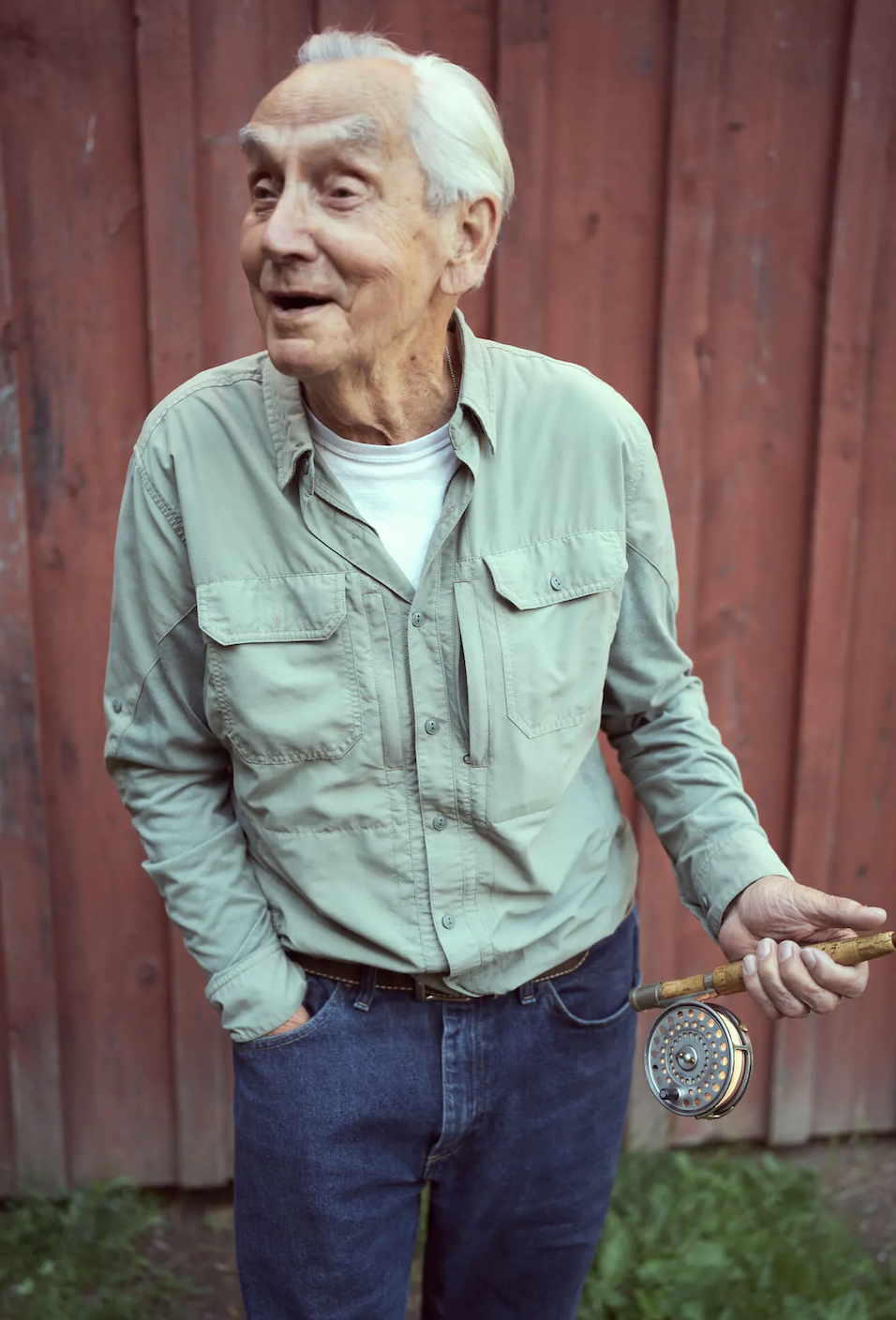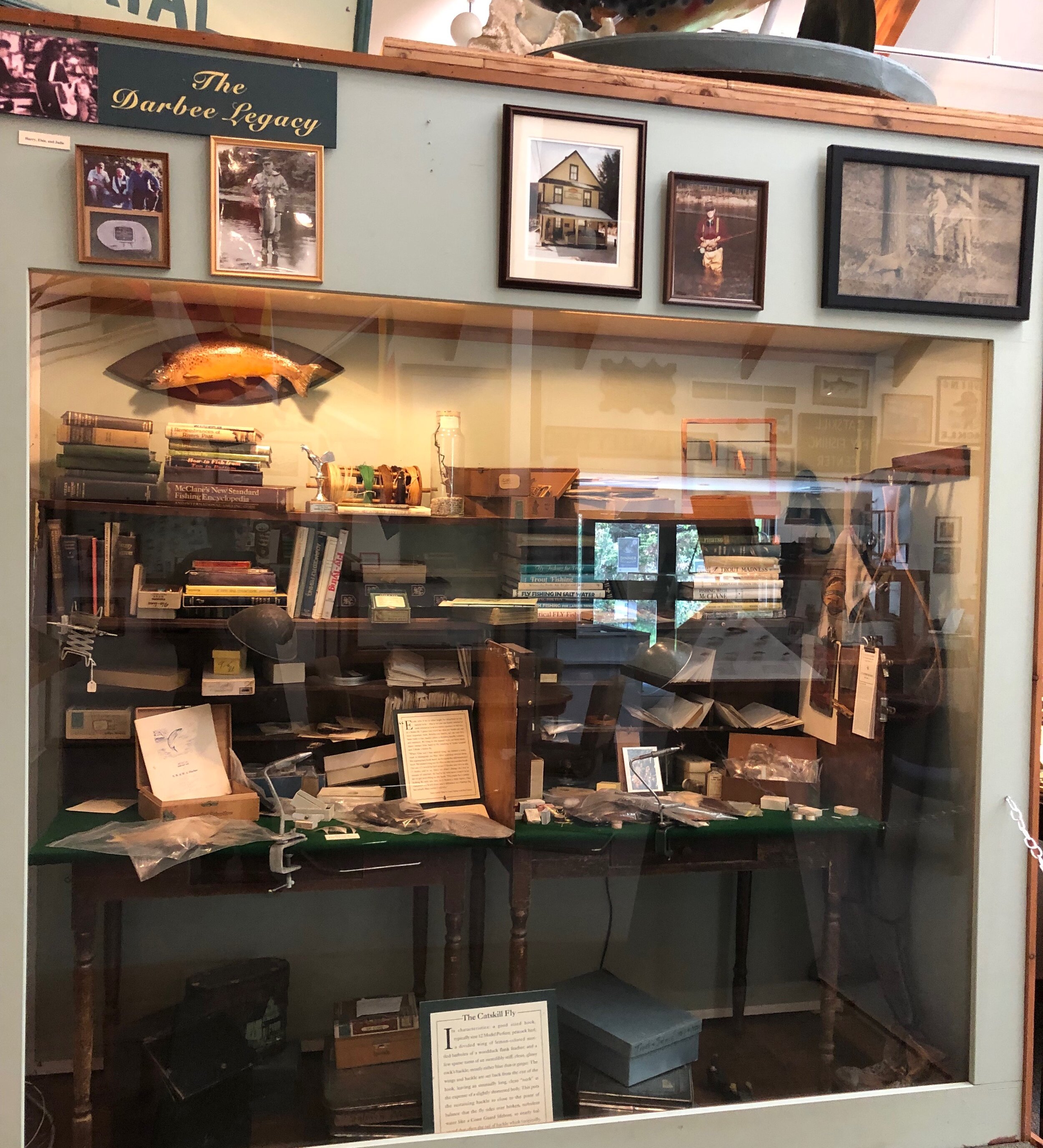
ED VAN PUT
Photography Photos by Christian Anwander
From the original article www.thewadinglist.com
1. Choice of equipment Rods, reels, fly lines, fly floatants, clothes, glasses and other useful items.
My prefered rod is a one piece Vince Cummings 8 foot 6 weight, the rod is fiberglass and because it has no ferrule it fishes like bamboo and it is very forgiving - if I strike to hard or quick, it bows to the fish and I believe I hook more fish because of this. Also, I believe graphite rods are generally too quick and often stiff and thereby unforgiving and the dry fly taken from the trout and the fish is missed.
I only use floating double tapered fly lines, they are the most accurate and I favor the color white. I believe that white is more difficult for the fish to see. If you think about it many creatures around water are white on their underside, fish, frogs, tadpoles, ducks etc. I believe this protects them from below and I think a white line against the sky is more difficult to see. I know it sounds quirky but everyone is entitled to a few odd habits.
2. Leader material, build up, length and knots.
I use self made leaders with a tippet of 5x, in the evening when it gets darker I would drop down to 4x because I would strike to a rise. I only make my own because purchased leaders are usually knot-less you never know the diameter of your tippet. With a home made leader I always know the length of my tippet because of the knots and this tells me when it is time to add a new tippet.
3. Approach and stealth.
Fishing with confidence is important. Often when I have fished with others, especially beginners, they react to the fish taking the fly with a little surprise - "oh he took it!" This is not good.
4. Reading the water.
Flat or slow moving water allows the fish to get a close-up and longer look at the fly, in fast water the fish must react quickly because the fly/food will pass him by quickly.
5. Casting ability which casts are essential.
I try to make my first cast the best because everyone after that is more likely to be less than perfect. I also expect the fish to take the fly when I am on target, in good position, and the fly is on a 'collision course' with the rising fish. I am never surprised when it takes, I may be surprised when it doesn't.
6. Entomology, what should we know.
We pay far too much attention to entomology and pay too much attention to exact imitation.
My prefered hatch is the Hendrikson.
7. Rise forms Can they tell us something?
A feeding (rising) trout, moves to surface and takes what is there at that particular time.
In a timed cycle the fish must take that fly. Like a 'collision course' the fish will commitment.
We have to take into account that stocked fish feed all at the same time where as wild fish react and feed with a hatch.
Ed learned to tie flies from Harry and Elsie Darbee, the noted Catskill tiers.
Fly tied by Elsie Darbee
8. Fly selection, size, shape, materials, which flies are essential?
The fly should be of the highest quality, it is the most important part of your equipment, you can have the finest rod, with the best reel, fly line, and leader but if the trout does not take the fly the equipment does not come into play - you need to fish with quality flies!
The fly is the most important thing between you and the fish, not the leader, line, rod or reel, the fly. Not the pattern, but how well it is tied, flies have to have correct proportions, tail, body, hackle, wings etc.
Fly size and color are very important, by color I mean light, medium and dark.
Profile matters In really calm water profile starts to matter because the fish has longer to observe the fly.
My flies are not overdressed I prefer a sparsely dressed fly.
Wing tips are extremely important, I once caught 36 fish on one fly! At the end the only thing left on the hook where the wings and it kept catching fish.
Hen hackles are a bad material for wings they don’t provide a crisp profile. The fibers of Hen tips are too soft.
Genetic hackles just come to a point and don’t give the profile I need for wings. I need an old fashioned neck not the new genetic hackles.
It is very difficult to get well-shaped grizzly hackle tips that are used to tie my favorite fly the Adams. I can see that wings of hackle tips would not absorb water as much as wood duck wings.
I allow myself time to tie my flies, I am not in a hurry, I want to make them the best I possibly can with the best possible materials I can find.
My favourite fly is an Adams.
An extract taken from Mike Valla's book "Founding Flies"
Ed Van Put
I began using the Adams in the 1960s. As is the case with many fly fishers, for the first several years I was hooked on “matching the hatch” and carried around a number of flies in many different sizes, tied to imitate the great variety of aquatic insects found along trout streams. I started to keep a diary of my experiences and recorded my catch: the species, whether the fish were wild or stocked, what they were taken on, water temperatures and a general description of what flies were on the water. Interestingly, the more I fished the more I found that I was catching the vast majority of trout on flies that imitated no specific hatch but were proven standards that had withstood the test of time, such as the Adams, Royal Coachman (both the hair wing and bivisible) Pheasant Tail Midge, Elk Hair Caddis and a couple of others. I did not set out to prove anything by using these flies; but in using them with success, it changed my philosophy about matching the hatch. It was also in the early 1960s that I began fishing the Delaware River for its large rainbow and brown trout. The fishing was demanding, mostly because the best way to fish it was with dry flies; and being a big river, long and accurate casts were necessary for success. The fish often worked only in the late evening, rising to spinner falls, beginning a half-hour to an hour before dark and continuing into the night. I began using an Adams at this time, at first tied ‘spent-winged,’ believing this was necessary during the spinner fall, but soon tied the more traditional upright-winged pattern. The fly was a great success on the Delaware - and I also began using it on all the streams I fished.
I tie the Adams in sizes #18 thru #12, though #14 is my favorite. I am very particular about the wings, and use a well-shaped fairly stiff hackle tip. I once fished the upper Beaverkill on a day that was exceptionally good, and caught 37 trout on the same fly. During this spree I lost the tail of the fly, then the body; and after a few more fish, the hackle came off - and with just the wings remaining, the fly took a couple more fish, including the largest of the day! I strongly believe you should tie or purchase the best-tied fly possible; by that I mean the fly should be tied with the best materials, and tied to the truest proportions. The fly is the first and single-most important item between you and the fish; it’s not the tippet, it’s not the leader, or the line, or the rod – it’s the fly! It is my belief that the Adams works exceptionally well because of the mixing of hackle - the red/brown hackle mixed with a grizzly hackle gives the fly a ‘broken’ or distorted image, not a solid one; and this causes the trout to see an optical image that is more consistent with a natural fly.
The Adams has a general blue/gray/brown appearance that is prevalent in many mayfly hatches. When cast among Hendricksons riding the water, the Adams blends in nicely with the naturals; the same is true with Isonychias that hatch a couple of times a year, or the many Blue-Winged Olive hatches that occur on our streams. I also think that in the evening when it is common for fly fishers to switch to a lighter fly for visibility, the Adams actually works better; being a dark fly it shows up well against the lighter sky, and trout looking up can see its shape better than that of a light-colored fly. Hands down, the Adams is my favorite of all the patterns out there. I have far and away caught more trout on the Adams than on all other flies combined; I salute Leonard Halladay for creating such a wonderful trout fly.
A precious Adams tied by Ed Van Put
I keep a diary to note down important facts. After studying my diary I came to the important conclusion that I was carrying dozens of flies with me on the river that I never used. From my diary I came to realize I need far fewer patterns and that size, shape, silhouette and color by that I mean light, medium or dark are very important.
There are times when pattern is vital, but they are few and far between. I liken these times to American football, after a touchdown the extra point is kicked, it is rare that that one point wins or loses a game.
9. Presentation and drifts.
Most people don’t put themselves in a good position to cast.
Rhythm is very important, fish have a rhythm when they rise and it is extremely important that your fly flows over the fish in the rhythm that they are taking naturals. When there is a good hatch on the water trout will start rising and take them on the surface, generally they don't move much from their position and you can time these rises with your false casting and attempt to drop the fly just ahead of the trout so that your fly and the fish are on a collision course.
10. Upstream or downstream?
I prefer an upstream presentation at a slight angle, this gives a good presentation and a good hook set.
You can get the best drag free float from this position, if you cast too much upstream the leader will come down ahead of the fly.


















